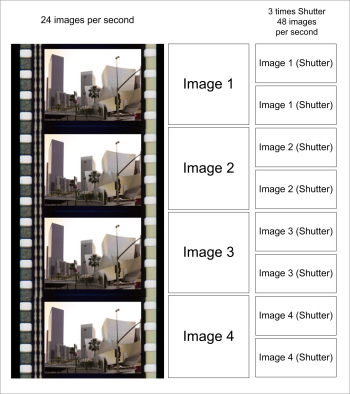

 |
 |
| 24 movie frames with a double shutter to create 48 images per second | 24 movie frames with a triple shutter to create 72 images per second |
Movies were and are shot and displayed in the frame rate of 24 frames per second, based on the development of film technology over time. As soon as movies are transferred to video frame rates a conversion must be considered. For PAL with a frame rate of 50 fps the regular method is the "PAL speed up": the 24 fps movie is transferred to the PAL medium with an up speed of 4.167 percent, resulting in a frame rate of 25 full images per second, resulting in an interlaced image with the frame rate of 25 with 50 fields. The slight up speed is visually not realized but the audio pitch change could be a larger problem. To solve this a pitch bending process is used, transferring audio back to the correct pitch while speeded the image and the audio track.
With NTSC video with a frame rate of 30 / 60 fps the speedup doesn't work, the movie's speed would be visible and audio re-pitching is difficult. Since "60" and "24" are no integer numbers, an uneven adjustment is necessary. The regular method is a 3:2 pulldown, there from one full image (progressive) alternatively two and three half images (interlaced) are created. This method has some serious drawbacks because the interlaced half images are not always corresponding correctly to each other. The so-called "Judder" is the result: camera moves will be displayed as a shaking image.
Another problem with the 3:2 pulldown: the interlaced video cannot be correctly de-interlaced into a progressive video (half frames don't fit). With a 60 fps display the best method to get a progressive video is to first re-create the 24 full frames. These 24 full frames are then displayed in an 3:2 sequence to get the 60 full images by playing alternatively one frame for three times (as a full progressive image) and the following frame for two times (also as a full progressive image).
Movies on BluRay Discs are normally encoded at the original 24 frames per second. Using a high quality display it should result in perfect image quality. But with 60 frames per second as standard frame rate for modern US flat displays the above issue must be solved too. Movies can be displayed with the 3:2 pulldown.
LCD displays show the image as long as it is active without a short space between. 24 images per second work in cinema only because the image is interrupted by a shutter wheel that is rotating in front of the lens, 'cutting' the 24 images into 48 (2 times) or 72 (three times). With each blank phase the eye (and the brain) simulates the missing image path and a smooth moving image is seen. With an LCD screen without blanks the 3 and the 2 partial images of the 3:2 pulldown are seen as static images and the change between the images is seen as a sudden change. With a fast moving camera shot the result could be a distorted flickering image. Here a solution is the artificial calculation of the 'missing' images between to create a smooth move from one image to the other. This works well but the created image can look artificial (the so-called 'soap effect', based on the visual impression of the cheep production technique for Soap Opera productions, with the impression that persons are 'disconnected' from the background image).